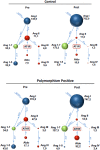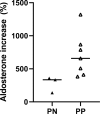Renin-angiotensin aldosterone profile before and after angiotensin-converting enzyme-inhibitor administration in dogs with angiotensin-converting enzyme gene polymorphism
- PMID: 32112596
- PMCID: PMC7097578
- DOI: 10.1111/jvim.15746
Renin-angiotensin aldosterone profile before and after angiotensin-converting enzyme-inhibitor administration in dogs with angiotensin-converting enzyme gene polymorphism
Abstract
Background: An angiotensin-converting enzyme (ACE) gene polymorphism occurs in dogs; however, functional importance is not well studied.
Hypothesis: We hypothesized that dogs with the polymorphism would show alternative renin-angiotensin aldosterone system (RAAS) pathway activation and classical RAAS pathway suppression before and after ACE-inhibitor administration, as compared to dogs without the polymorphism that would show this pattern only after ACE-inhibitor administration.
Animals: Twenty-one dogs with mitral valve disease that were genotyped for the ACE gene polymorphism.
Methods: This retrospective study utilized stored samples from 8 ACE gene polymorphism-negative (PN) dogs and 13 ACE gene polymorphism-positive (PP) dogs before and after enalapril administration. Equilibrium analysis was performed to evaluate serum RAAS metabolites and enzyme activities. Results were compared before and after enalapril, and between groups.
Results: The classical RAAS pathway was suppressed and the alternative RAAS pathway was enhanced for both genotypes after administration of enalapril, with no differences before enalapril administration. Aldosterone breakthrough occurred in both PN (38%) and PP (54%) dogs despite angiotensin II suppression. Aldosterone was significantly higher (P = .02) in ACE gene PP dogs (median, 92.17 pM; IQR, 21.85-184.70) compared to ACE gene PN dogs (median, 15.91 pM; IQR, <15.00-33.92) after enalapril.
Conclusions and clinical importance: The ACE gene polymorphism did not alter baseline RAAS activity. Aldosterone breatkthrough in some dogs suggests nonangiotensin mediated aldosterone production that might be negatively influenced by genotype. These results support the use of aldosterone receptor antagonists with ACE-inhibitors when RAAS inhibition is indicated for dogs, especially those positive for the ACE gene polymorphism.
Keywords: ACE-inhibitor; enalapril; genotype; pharmacogenetic; pharmacogenomic.
© 2020 The Authors. Journal of Veterinary Internal Medicine published by Wiley Periodicals, Inc. on behalf of the American College of Veterinary Internal Medicine.
Conflict of interest statement
Dr. Adin has received funding from CEVA Animal Health. Dr. Atkins has received funding and has consulted for CEVA Animal Health, Boehringer‐Ingelheim, and Vetoquinol. Dr. Meurs has received funding from the Morris Animal Foundation for parts of this study. Dr. Domenig is employed by Attoquant Diagnostics.
Figures


References
-
- Sztechman D, Czarzasta K, Cudnoch‐Jedrzejewska A, et al. Aldosterone and mineralocorticoid receptors in regulation of the cardiovascular system and pathological remodelling of the heart and arteries. J Physiol Pharmacol. 2018;69:829‐845. - PubMed
-
- Sisson DD. Neuroendocrine evaluation of cardiac disease. Vet Clin North Am ‐ Small Anim Pract. 2004;34:1105‐1126. - PubMed
-
- Fujii Y, Orito K, Muto M, Wakao Y. Modulation of the tissue renin‐angiotensin‐aldosterone system in dogs with chronic mild regurgitation through the mitral valve. Am J Vet Res. 2007;68:1045‐1050. - PubMed
MeSH terms
Substances
Grants and funding
LinkOut - more resources
Full Text Sources
Miscellaneous

